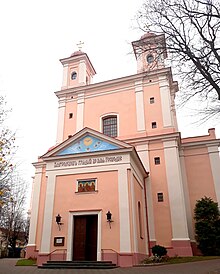| This article needs additional citations for verification. Please help improve this article by adding citations to reliable sources. Unsourced material may be challenged and removed. Find sources: "Russian Orthodox Diocese of Lithuania" – news · newspapers · books · scholar · JSTOR (May 2023) (Learn how and when to remove this message) |

The Diocese of Vilnius and Lithuania (Lithuanian: Vilniaus ir Lietuvos vyskupija; Russian: Виленская и Литовская епархия), also known as the Lithuanian Orthodox Church (Lithuanian: Lietuvos stačiatikių bažnyčia; Russian: Литовская православная церковь), is a diocese of the Russian Orthodox Church whose territory comprises the country of Lithuania, established in 1839 after the Synod of Polotsk when the Uniate Eparchy of Vilnius was united to the Orthodox Church. Its ruling bishop is appointed by the Holy Synod of the Moscow Patriarchate. Its headquarters is at the Holy Spirit Monastery in Vilnius, though nominally its cathedral is the Dormition Cathedral in Vilnius. Since 2010, its current head is Metropolitan Innocent (Vasilyev).
The diocese includes five deaneries, based in municipal Vilnius, regional Vilnius, Kaunas, Klaipėda, and Visaginas, with 52 parishes and two monasteries. The majority of parishioners come from the resident Slavic minorities.
History

Orthodox Christianity first entered Lithuania in significant numbers in the 13th century with the conversion of some of its early nobles from paganism. Among these were the Three Martyrs of Vilnius, Anthony, John, and Eustathius, martyred in 1347 under the Grand Duke Algirdas.
Formally established Orthodox parishes in Lithuania and in the surrounding region ultimately derive from the short-lived fourteenth-century Metropolis of Lithuania and its successor jurisdictions (based largely in Kyiv), which had been under the Ecumenical Patriarchate of Constantinople. In the seventeenth century, the institutional presence of Orthodox Christianity was effectively erased from Lithuania as a result of the Union of Brest, when Lithuania was part of the Polish-Lithuanian Commonwealth. At that time, all the Orthodox parishes in Lithuania left the Orthodox Church and joined the Catholic Church.
In the late 18th century, with the Partitions of the Polish-Lithuanian Commonwealth, Lithuania became part of the Russian Empire. The modern Russian Orthodox diocese was founded in 1839 with the incorporation of the Uniate eparchy of Vilnius under Metropolitan Joseph Semashko into the Russian church at the Synod of Polotsk. Among the more notable hierarchs of Lithuania in the later imperial period was St. Tikhon (Bellavin), who served in the post 1913–1917.

The diocese functioned within the Russian empire until Lithuania became independent in 1918. At that time, a number of the churches that had been taken from the Catholic Church were returned, and certain Orthodox churches, such as Archangel Michael Church in Kaunas, were also given to the Catholic Church. Most of the Orthodox parishes that exist today in Lithuania were built during the imperial period (1795–1918).
In the wake of World War I, part of Lithuania was controlled by Poland, including the capital Vilnius. During that time, with the autocephaly of the Polish Orthodox Church in 1924, the parishes in that region were part of the Polish church.
As a result of World War II, Lithuania again became subjugated to Russia, this time as part of the Soviet Union, which transferred Vilnius into the Lithuanian SSR and moved the parishes that had been part of the Polish church back to the Moscow Patriarchate. While religion was persecuted in Soviet Lithuania just as it was elsewhere in the Soviet Union, the Orthodox diocese was generally tolerated more than the Roman Catholic Church (to which the great majority of Lithuanians belonged), because its seat of authority was inside the Soviet Union.
In 1990, Lithuania again regained independence. The head of the diocese at the time, Archbishop Chrysostom (Martishkin), openly supported Lithuanian independence. He was succeeded in 2010 by Metropolitan Innocent (Vasilyev).
Present Day
After the Russian invasion of Ukraine in 2022, Patriarch Kirill of Moscow defrocked five priests from the diocese of Vilnius and Lithuania who expressed opposition to the patriarch's position regarding the war. Using the right of appeal, they turned to the Ecumenical Patriarch, who acquitted them on February 2023 and restored them in their priestly ministry. In March 2023, Patriarch Bartholomew paid an official visit to Lithuania. During it, the Patriarch met with five restored priests and provided for the creation of the ecclesiastical jurisdiction of the Ecumenical Patriarchate in the country.
In 2024 a priest of the Estonian Apostolic Orthodox Church, Justinus Kiviloo, was appointed as the Exarch of Lithuania. The Exarchate includes ten parishes serving in Lithuanian, Belarusian, Ukrainian and Russian languages.
See also
References
- "Виленская епархия". patriarchia.ru.
- "ВИЛЕНСКО-ЛИТОВСКАЯ ЕПАРХИЯ". orthodoxy.lt.
- "Митрополит Виленский и Литовский Хризостом почислен на покой по состоянию здоровья / Новости / Патриархия.ru". Патриархия.ru.
- ^ "Благочиния". orthodoxy.lt.
- ^ "Orthodoxy in Lithuania". truelithuania.com.
- "Martyrs Anthony, John, and Eustathius of Vilnius". oca.org.
- "The Union of Brest-Litovsk". oca.org.
- "ST. MICHAEL THE ARCHANGEL'S CHURCH (A.K.A. THE GARRISON CHURCH)". kaunas.lt.
- "METROPOLITAN OF LITHUANIA ON UKRAINE: THE VOICE OF THE CHRISTIAN CONSCIENCE CRIES OUT TO HEAVEN". orthochristian.com.
- https://en.ortodoksas.lt/2024/05/patriarchal-exarchate-of-lithuania.html